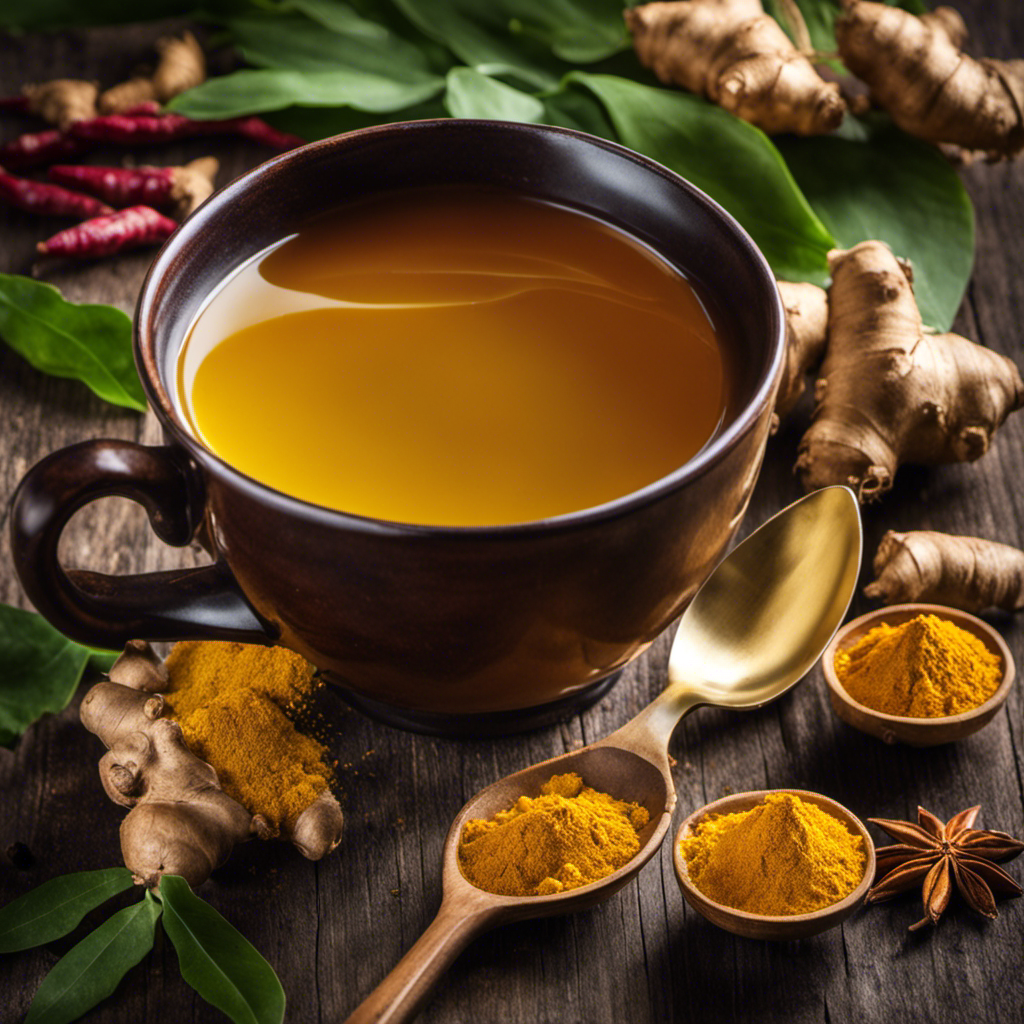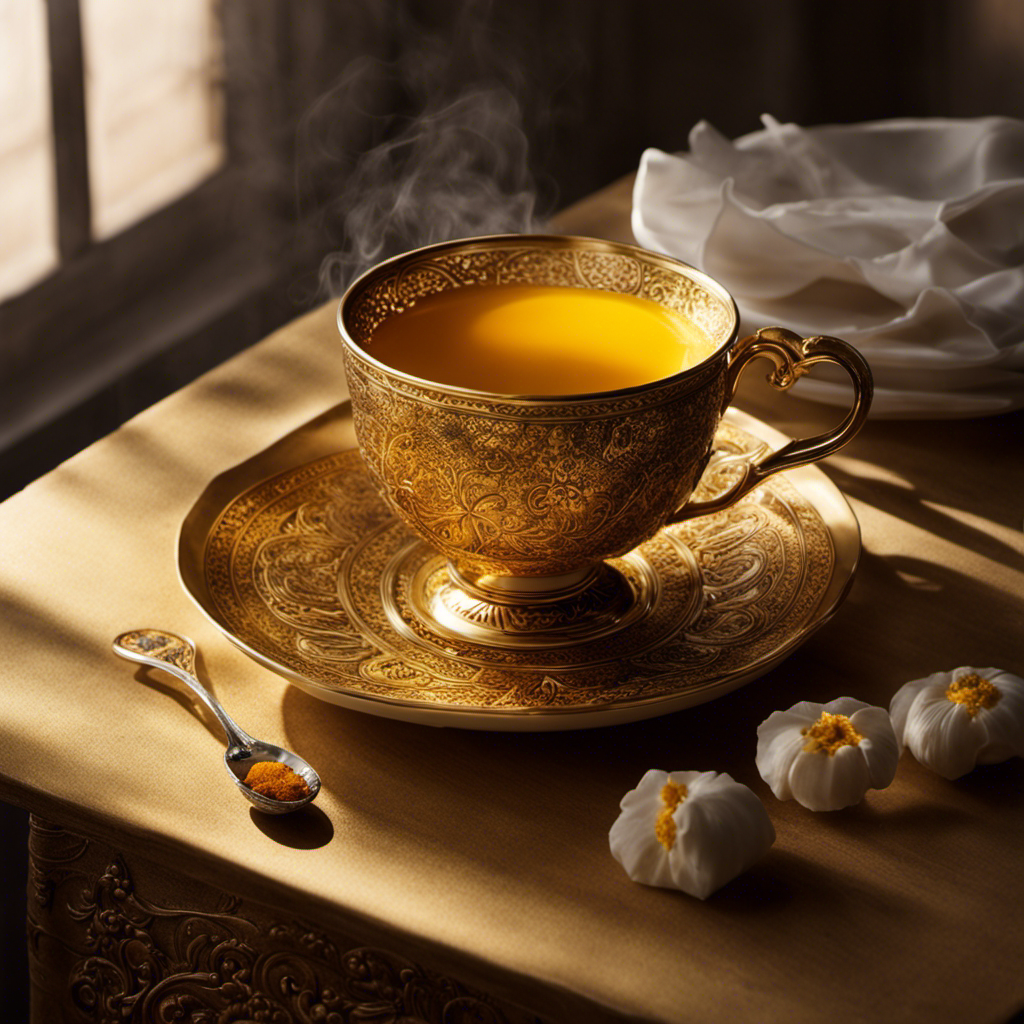Matcha
Exploring The Matcha: Benefits, Recipes & Tips

Welcome to the world of matcha, where a humble green powder holds the power to nourish and uplift.
At The Matcha, we invite you to join us on a journey of serving others through the art of this exceptional tea. With every sip, we embrace the symbolism of unity, harmony, and balance that matcha represents.
From its origins in ancient Japan to its modern-day popularity, we explore the rich history and production process that gives matcha its distinctive flavor and vibrant green color.
Discover the various grades of matcha and unlock the health benefits it offers, from boosting metabolism to promoting overall well-being.

Whether you’re a tea connoisseur or a curious newcomer, we are here to guide you through the enchanting world of matcha.
Key Takeaways
- Matcha is a powdered green tea that originated in China and was brought to Japan by a Buddhist monk in the 12th century. It is integral to Zen Buddhist rituals and meditation practices.
- Matcha is produced through a meticulous process that involves shading the tea plants before harvest, hand-picking the finest leaves, steaming, drying, and then grinding them into a fine powder using traditional granite stone mills.
- There are different grades of matcha, including ceremonial grade, premium grade, culinary grade, and cooking grade, each suited for different taste preferences and culinary needs.
- Matcha offers numerous health benefits, such as detoxification, boosting metabolism, providing natural energy, being rich in antioxidants, supporting the immune system, enhancing concentration and focus, and promoting weight loss. It also has properties that cleanse and purify the body and support liver health.
The Origins of Matcha
In our exploration of the origins of matcha, let’s travel back in time to the 12th century. Matcha cultivation has a deep historical significance, originating in ancient China and later being embraced by the Japanese. It was during the Tang Dynasty in China that the cultivation of tea leaves and the preparation of powdered tea first began. However, it was the Zen Buddhist monks in Japan who truly elevated matcha to its current level of importance.
During the 12th century, the Zen Buddhist monk, Eisai, brought back the knowledge of matcha cultivation from China to Japan. He believed in its potential to enhance meditation and promote a state of calmness and focus. Matcha became an integral part of Zen Buddhist rituals and was consumed by monks to aid in their meditation practices.
The cultivation of matcha involves shading the tea plants for several weeks before harvest, which helps to increase the chlorophyll content and enhance the flavor and color of the leaves. After harvesting, the leaves are steamed, dried, and ground into a fine powder using traditional stone mills.

The historical significance of matcha lies in its connection to Zen Buddhism and its role in promoting a sense of mindfulness and tranquility. Now that we understand the origins of matcha, let’s delve deeper into the production process.
The Production Process
To understand the intricacies of matcha production, we delve into the meticulous process that transforms tea leaves into the vibrant green powder enjoyed around the world. The production of matcha involves several production techniques and a carefully executed harvesting process.
The production process begins with the cultivation of shade-grown tea plants. These plants are covered with shade cloths for several weeks before harvesting. This method enhances the chlorophyll content in the leaves, resulting in the vibrant green color of matcha.
Once the leaves are ready for harvest, skilled farmers carefully hand-pick the young leaves, selecting only the finest quality. This manual harvesting process ensures that only the most tender and nutrient-rich leaves are chosen.

After harvesting, the leaves undergo a series of meticulous steps to transform them into matcha powder. The leaves are steamed to prevent oxidation, then dried and deveined. The dried leaves are then ground into a fine powder using traditional granite stone mills.
The production of matcha requires precision and attention to detail, as each step contributes to the unique flavor and quality of the final product. Understanding the production process is essential in appreciating the different matcha grades and their characteristics.
With a solid understanding of the production process, we can now transition into the next section, where we’ll explore the fascinating world of understanding matcha grades.
Understanding Matcha Grades
First, let’s dive into the various grades of matcha and explore their unique characteristics. When it comes to matcha, different grades are determined by the quality of the leaves used and the processing methods employed. Understanding matcha grades is essential in choosing the right one for your palate and preferences.

Here are four key grades to consider:
- Ceremonial Grade: This is the highest grade of matcha, made from the youngest leaves. It has a vibrant green color, a smooth and creamy texture, and a delicate flavor with hints of sweetness and umami. Ceremonial grade matcha is perfect for traditional tea ceremonies and for those who appreciate the finest flavors.
- Premium Grade: Falling just below ceremonial grade, premium grade matcha is made from slightly older leaves. It has a more robust flavor profile, with a balance of bitterness and sweetness. This grade is ideal for those who enjoy a stronger matcha taste.
- Culinary Grade: As the name suggests, culinary grade matcha is primarily used for cooking and baking. It has a stronger and more bitter taste, making it perfect for adding matcha flavor to recipes like smoothies, desserts, and savory dishes.
- Cooking Grade: This is the lowest grade of matcha and is typically used in large-scale food production. It has a more astringent and less vibrant flavor compared to higher grades. Cooking grade matcha is best suited for recipes where the matcha flavor isn’t the primary focus.
Understanding the different matcha grades allows you to choose the one that best suits your taste preferences and culinary needs. Whether you’re looking for a delicate and refined flavor or a stronger and more robust taste, there’s a matcha grade out there for you. Experiment and explore the world of matcha to find your perfect cup.
Health Benefits of Matcha
Let’s talk about the health benefits of matcha.
Matcha is known for its detoxification properties, helping to eliminate toxins from the body.

Additionally, matcha can boost metabolism and provide a natural source of energy, making it a great choice for those looking to stay active and alert throughout the day.
Detoxification Properties of Matcha
The detoxification properties of matcha offer numerous health benefits. Here are four reasons why matcha is a powerful detoxifying agent:
- Boosts Immunity: Matcha contains high levels of antioxidants called catechins, which help strengthen the immune system and protect the body against infections and diseases.
- Detoxifying Antioxidants: Matcha is packed with detoxifying antioxidants, such as chlorophyll, which helps remove harmful toxins and heavy metals from the body.
- Cleanses the Body: The high concentration of antioxidants in matcha helps to cleanse the body by neutralizing free radicals and reducing oxidative stress.
- Supports Liver Health: Matcha contains compounds that support liver function and aid in the detoxification process, helping the liver to efficiently remove toxins from the body.
By incorporating matcha into your diet, you can enjoy these detoxification benefits and support a healthier body.
Now, let’s move on to how matcha boosts metabolism and energy.

Boosts Metabolism and Energy
To continue exploring the health benefits of matcha, we can delve into how it boosts metabolism and energy.
Matcha is known for its ability to enhance energy levels, making it a popular choice for those seeking an all-natural energy boost. This is due to the presence of caffeine in matcha, which provides a sustained release of energy without the jitters or crash often associated with other sources of caffeine.
Additionally, matcha contains a unique amino acid called L-theanine, which promotes a state of calm alertness and further enhances energy levels. The combination of caffeine and L-theanine in matcha provides a natural and balanced boost of energy that can help improve focus, productivity, and overall well-being.
Furthermore, matcha has been shown to support weight loss efforts by boosting metabolism and promoting fat oxidation. Its high concentration of catechins, a type of antioxidant, has been found to increase thermogenesis (the body’s rate of burning calories) and aid in weight management.
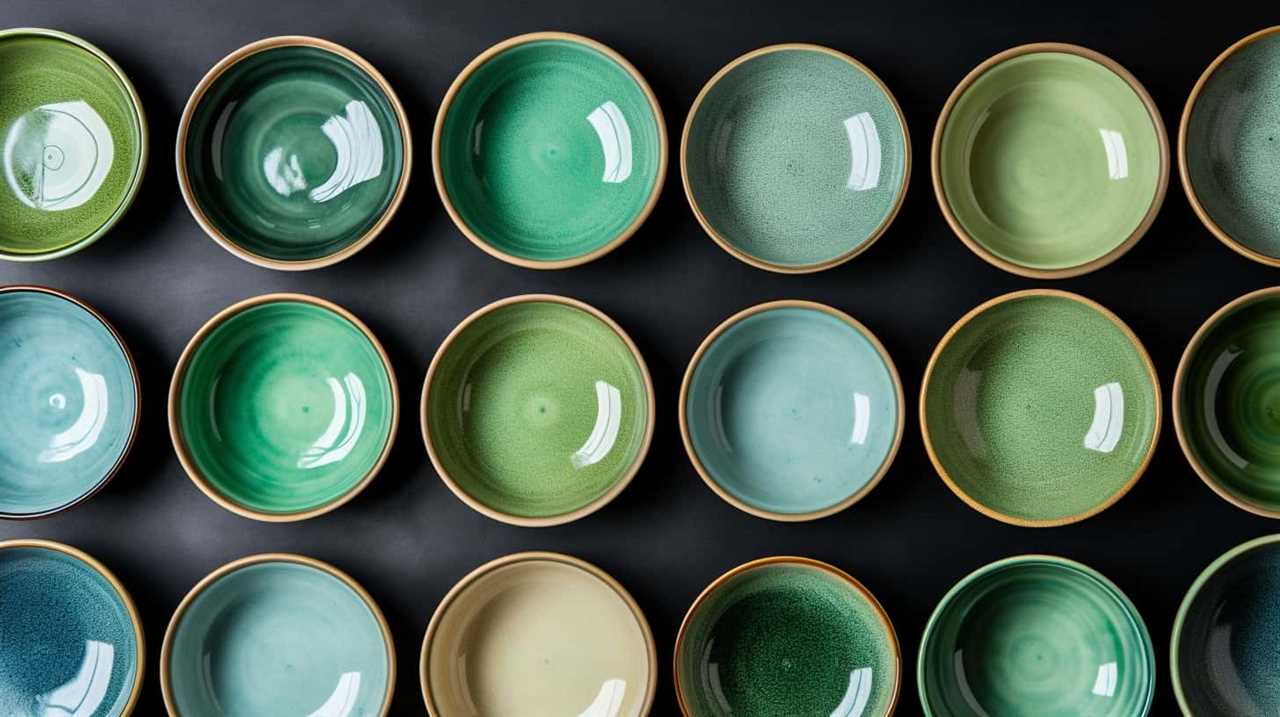
With its numerous health benefits, matcha is truly a powerhouse when it comes to boosting energy levels and supporting weight loss goals.
In the next section, we’ll explore how matcha can further enhance metabolism and its impact on overall health.
Boosting Metabolism With Matcha
Let’s talk about how matcha can help boost our metabolism and aid in calorie burning.
Matcha contains catechins, a type of antioxidant that has been shown to increase thermogenesis, the process by which our bodies burn calories.
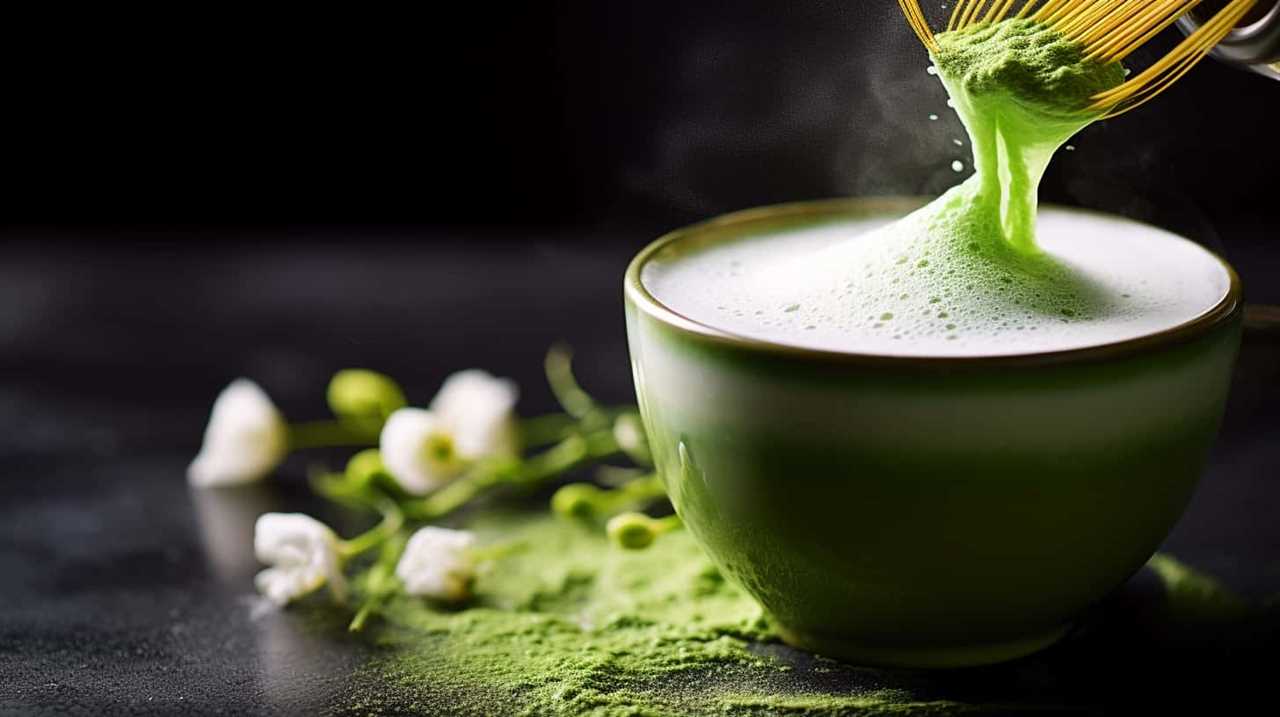
Additionally, matcha has been found to enhance fat oxidation, meaning it helps our bodies break down and use fat as an energy source.
Matcha and Calorie Burning
We can enhance our calorie burning and boost our metabolism by incorporating matcha into our daily routine. Matcha is a powerful green tea powder that offers numerous health benefits, including its ability to aid in weight loss.
Here are four ways matcha can help with calorie burning and weight loss:
- Increased thermogenesis: Matcha contains catechins, which have been shown to increase thermogenesis, the process by which our bodies burn calories to produce heat.
- Boosted metabolism: Matcha is rich in antioxidants called EGCG, which can help increase our metabolic rate and burn calories more efficiently.
- Appetite suppression: Matcha contains a natural compound called L-theanine, which has been found to reduce feelings of hunger and promote satiety.
- Energy boost: Matcha contains caffeine, which can provide a natural energy boost and increase our physical activity, leading to more calorie burning.
Matcha’s Metabolic Benefits
While incorporating matcha into our daily routine, we can experience the metabolic benefits of this powerful green tea powder. Matcha has been shown to boost metabolism, making it a valuable tool for those looking to support weight loss efforts. The catechins found in matcha have been found to increase thermogenesis, which is the process by which our bodies burn calories to produce heat. This means that consuming matcha can help increase our calorie-burning potential, even when at rest.
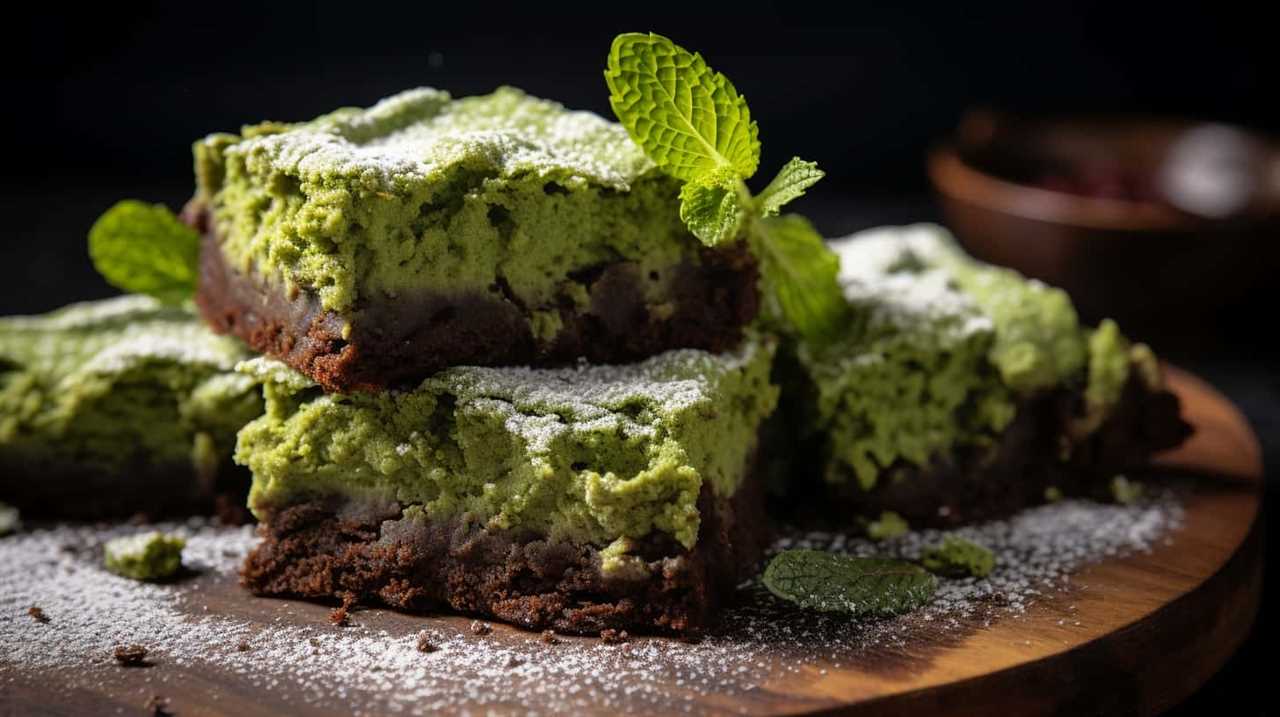
Additionally, matcha contains caffeine, which can further enhance metabolism and fat oxidation. By incorporating matcha into our daily routine, we can harness its metabolic benefits to support our weight loss goals.
Now, let’s explore how matcha can also help us improve our concentration and focus.
Matcha for Improved Concentration
Using a daily dose of matcha can significantly enhance our concentration levels. Matcha, a finely ground powder made from shade-grown green tea leaves, has been used for centuries in traditional Japanese tea ceremonies. It contains a unique combination of caffeine and L-theanine, an amino acid that promotes relaxation and mental clarity. Here are four ways matcha can boost focus and improve studying:
- Increased Alertness: Matcha provides a gentle and sustained energy boost without the jitters or crash associated with coffee. Its caffeine content helps to improve alertness and focus, allowing us to stay engaged and productive for longer periods.
- Enhanced Cognitive Function: The L-theanine in matcha stimulates the production of alpha waves in the brain, promoting a relaxed yet alert state of mind. This combination of caffeine and L-theanine improves cognitive function, memory, and attention span.
- Reduced Stress and Anxiety: Matcha’s L-theanine content has been found to have calming effects on the brain, reducing stress and anxiety levels. This helps to create a focused and centered mindset, ideal for studying or completing tasks that require concentration.
- Improved Mood and Motivation: Matcha contains polyphenols, which have been shown to have mood-enhancing properties. These antioxidants help to reduce feelings of fatigue and increase motivation, making it easier to stay focused and engaged.
By incorporating matcha into our daily routine, we can experience improved concentration, increased alertness, reduced stress, and enhanced cognitive function.

Now, let’s explore how matcha can serve as a natural detoxifier.
Matcha as a Natural Detoxifier
To begin our exploration of matcha as a natural detoxifier, let’s examine its ability to cleanse and purify the body. Matcha has long been revered for its detoxification benefits, helping to eliminate toxins and promote overall wellness. One of the key reasons matcha is so effective as a detoxifier is its high concentration of chlorophyll, a powerful antioxidant that aids in the removal of harmful substances from the body.
In addition to its detoxification properties, matcha is also known to support weight loss efforts. The catechins found in matcha have been shown to boost metabolism and increase fat oxidation, making it an ideal beverage for those looking to shed a few pounds. By incorporating matcha into a balanced diet and exercise routine, individuals can experience enhanced weight loss results.
To better understand the detoxification benefits and weight loss potential of matcha, let’s take a closer look at the following table:
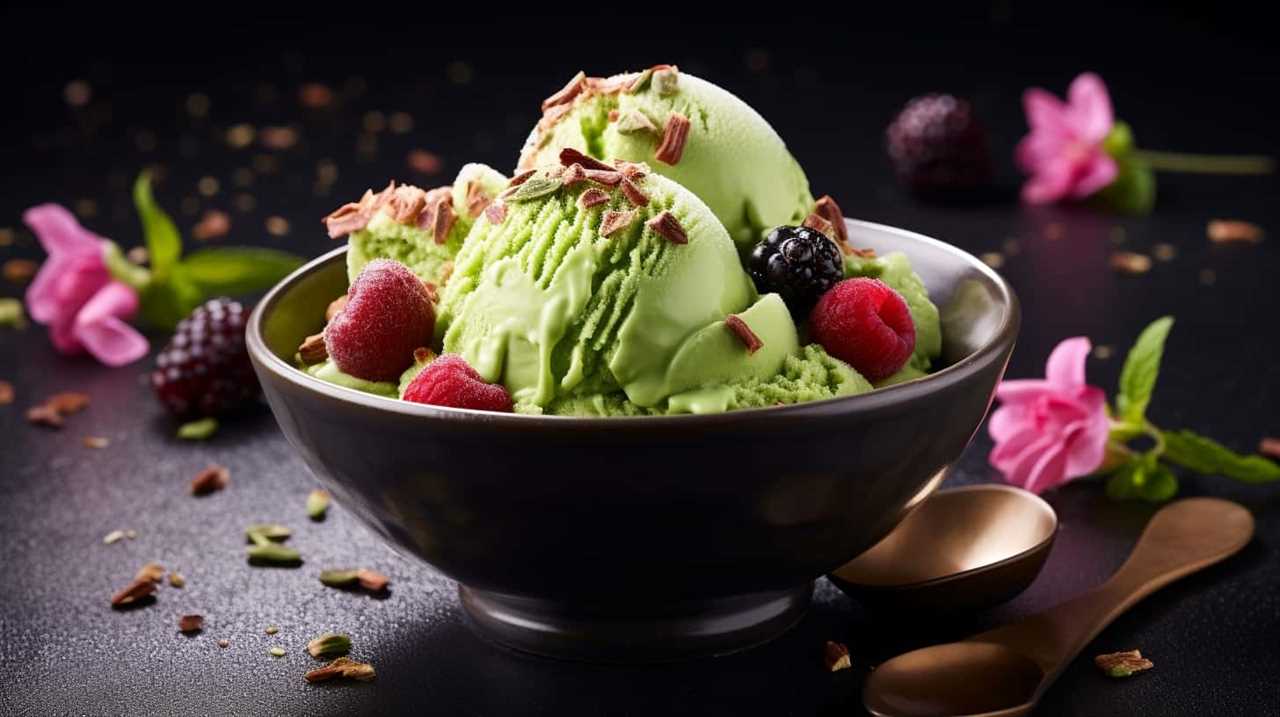
| Detoxification Benefits | Matcha for Weight Loss |
|---|---|
| Eliminates toxins | Boosts metabolism |
| Purifies the body | Increases fat oxidation |
| Supports overall wellness | Aids in weight loss |
| Enhances digestion | Promotes a healthy weight |
As you can see, matcha offers a range of benefits when it comes to detoxification and weight loss. By incorporating this vibrant green tea into your daily routine, you can support your body’s natural detoxification processes and achieve your weight loss goals. So why not give matcha a try and experience the transformative power of this natural detoxifier firsthand?
Incorporating Matcha Into Your Daily Routine
Now that we’ve learned about the detoxifying benefits of matcha, let’s explore how we can incorporate it into our daily routines.
Starting the day with a cup of morning matcha can provide a natural boost of energy and focus to kickstart our mornings.
We can also get creative in the kitchen and experiment with matcha-infused recipes, from smoothies to baked goods, to enjoy its unique flavor and health benefits.
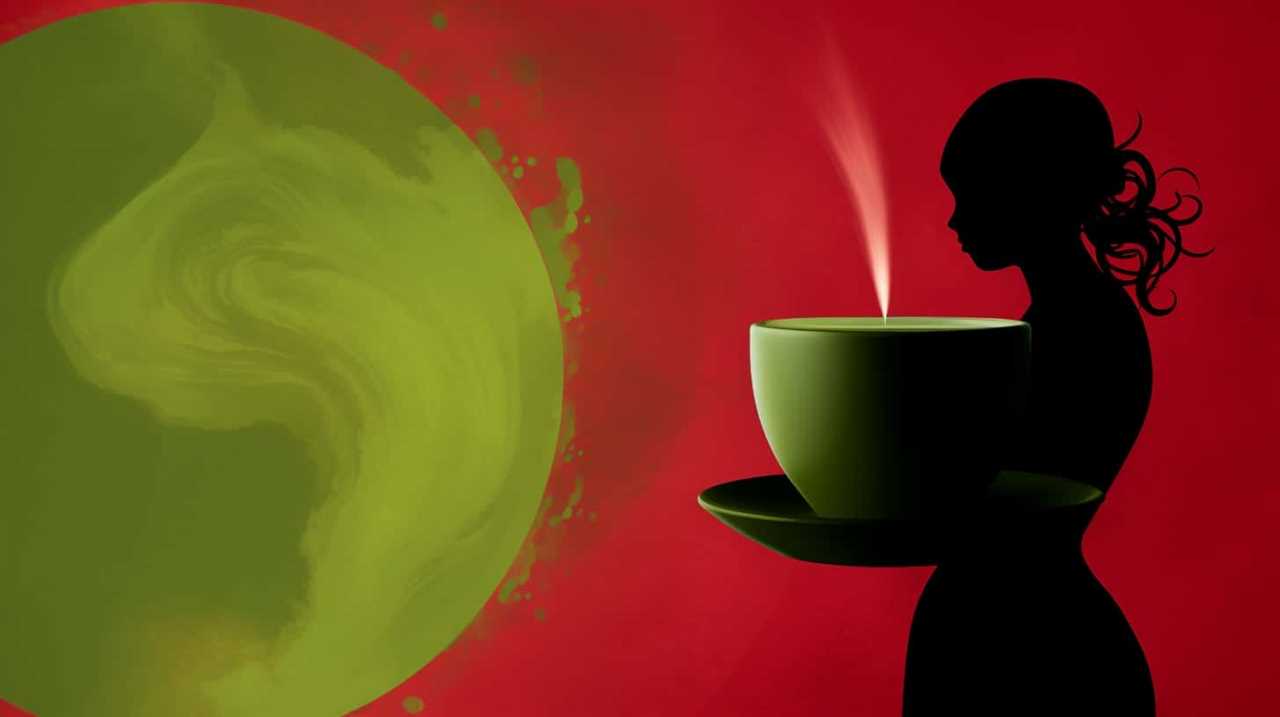
Lastly, matcha can be a great substitute for coffee or sugary drinks, offering a healthier option to satisfy our cravings.
Morning Matcha Benefits
Every morning, we incorporate matcha into our daily routine to reap its numerous health benefits. Matcha isn’t only delicious but also packed with antioxidants that help to boost focus and improve cognitive function.
Here are four reasons why you should consider adding matcha to your morning routine:
- Increased Energy: Matcha contains caffeine, which provides a natural and sustained energy boost without the jitters or crash associated with coffee.
- Weight Loss Aid: Matcha has been shown to increase metabolism and help with weight loss. Its high concentration of catechins promotes fat oxidation and thermogenesis.
- Detoxification: Matcha is rich in chlorophyll, which helps to cleanse the body of toxins and support liver function.
- Calming Effect: Matcha contains L-Theanine, an amino acid that promotes relaxation and reduces stress.
Matcha in Recipes
After enjoying the numerous health benefits of incorporating matcha into our morning routine, we can now explore how to incorporate matcha into our daily recipes.
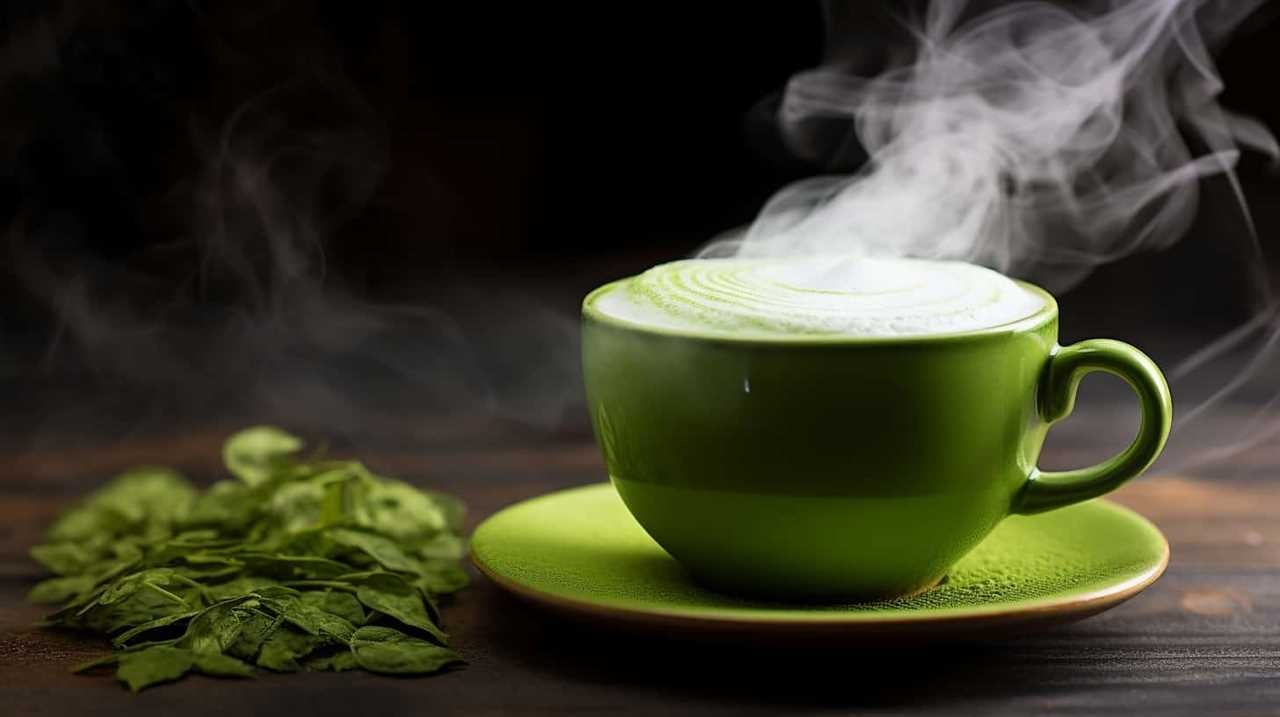
Matcha, with its vibrant green color and unique flavor, can add a delightful twist to a variety of dishes. From smoothies and lattes to baked goods and desserts, the possibilities are endless. We can experiment with different matcha flavors, such as adding fruity or floral notes, to create a personalized taste experience.
Additionally, matcha can also be used in skincare routines. Its antioxidant properties can help rejuvenate and nourish the skin, leaving it feeling refreshed and revitalized.
Matcha as a Substitute
To fully embrace the versatility of matcha, we can seamlessly incorporate it into our daily routine as a substitute for other ingredients. Here are four ways to incorporate matcha into your daily routine:
- Replace your morning coffee with a matcha latte. The vibrant green color and rich, earthy flavor of matcha will give you a gentle energy boost without the jitters.
- Swap out regular flour for matcha powder in your baking recipes to add a unique, grassy flavor to your favorite desserts. Matcha cupcakes, matcha cookies, and matcha cheesecake are just a few examples of the delicious treats you can create.
- Use matcha as a natural food coloring alternative. Instead of artificial dyes, add a pinch of matcha powder to your frosting or icing to achieve a beautiful green hue.
- Sprinkle matcha powder over your favorite dishes, like salads or smoothie bowls, for a pop of color and a nutritional boost.
Exploring Matcha Recipes
Let’s dive into exploring matcha recipes and discover the delightful ways we can incorporate this vibrant green tea powder into our culinary creations. Matcha isn’t only delicious as a hot or iced beverage, but it can also add a unique and vibrant flavor to a variety of desserts.

One popular matcha recipe is the matcha latte. This creamy and frothy drink combines the earthiness of matcha with the smoothness of milk. To make a matcha latte, simply whisk together matcha powder, hot water, and your choice of milk. Add a touch of sweetness with honey or maple syrup, and enjoy the comforting and energizing qualities of this warm beverage.
When it comes to matcha desserts, the possibilities are endless. From matcha-infused cookies and cakes to matcha ice cream and truffles, there’s something for everyone’s sweet tooth. Matcha’s slightly bitter and grassy flavor pairs perfectly with the sweetness of desserts, creating a balanced and satisfying treat.
Whether you’re a fan of warm beverages or sweet treats, incorporating matcha into your recipes can add a unique and vibrant twist to your culinary creations. So go ahead, grab your matcha powder, and let your creativity flow in the kitchen. Your taste buds will thank you.
Matcha Vs. Regular Green Tea
While matcha is a type of green tea, there are some key differences between matcha and regular green tea. Here are four important distinctions to consider:
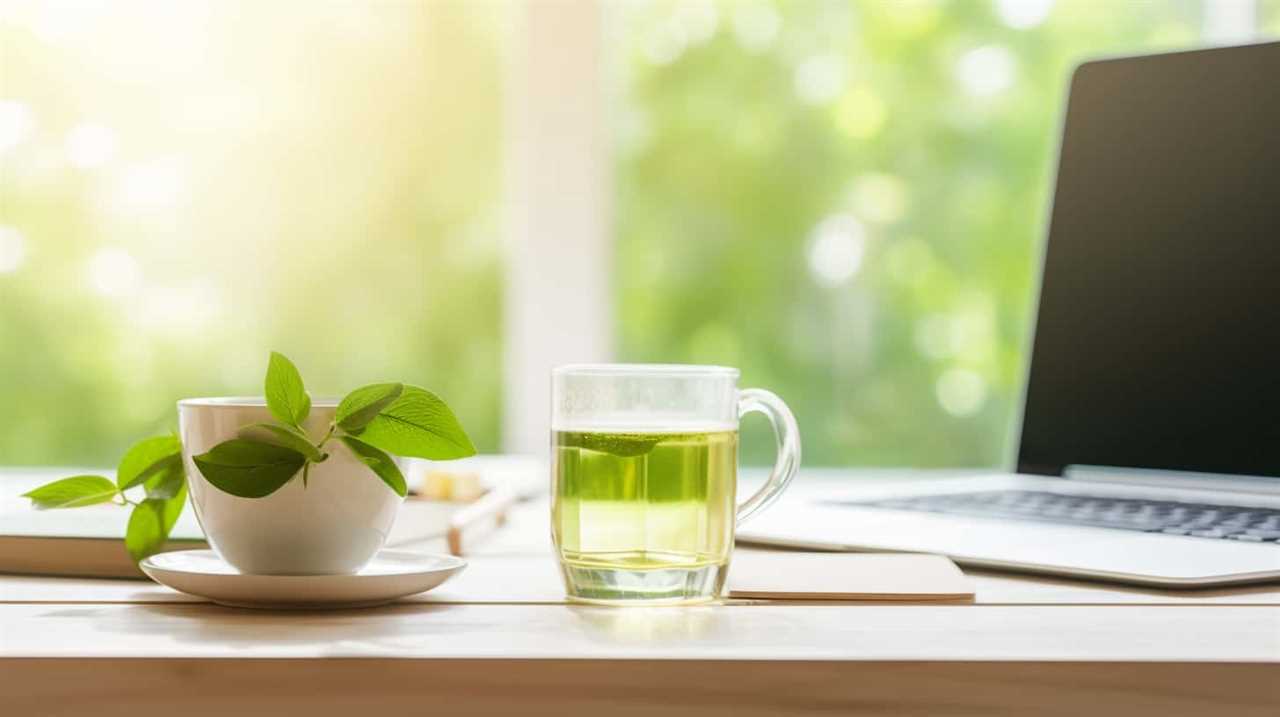
- Caffeine content: Matcha contains a higher concentration of caffeine compared to regular green tea. This is because when you drink matcha, you consume the whole ground tea leaves, whereas with regular green tea, you steep the leaves and then discard them. So, if you’re looking for a morning pick-me-up or an energy boost, matcha might be the better choice.
- Antioxidant properties: Matcha is renowned for its abundant antioxidants. In fact, it contains significantly higher levels of antioxidants compared to regular green tea. The reason behind this is that matcha is grown in the shade, which increases the production of chlorophyll and amino acids, resulting in a higher concentration of antioxidants. These antioxidants help protect the body against free radicals and promote overall well-being.
- Preparation method: Matcha is prepared by whisking the powdered tea with hot water until it becomes frothy, whereas regular green tea is made by steeping tea leaves in hot water. The unique preparation method of matcha gives it a distinct flavor and texture.
- Taste profile: Matcha has a rich, earthy flavor with a hint of sweetness, while regular green tea has a more subtle and grassy taste. Matcha’s vibrant green color and velvety texture also contribute to its appeal.
Matcha in Traditional Japanese Tea Ceremonies
Moving from the previous subtopic, we delve into the significance of matcha in Traditional Japanese Tea Ceremonies. Japanese tea traditions hold a deep reverence for matcha, considering it as more than just a beverage. Matcha plays a central role in the ceremonial tea preparation, known as "chanoyu" or "the way of tea."
In these tea ceremonies, matcha is prepared and served with meticulous attention to detail, symbolizing harmony, respect, purity, and tranquility. The focus is not only on the taste but also on the entire experience of preparing and serving the tea.
To understand the importance of matcha in Japanese tea ceremonies, let’s take a look at the following table:
| Japanese Tea Ceremonies | ||
|---|---|---|
| Purpose | Key Elements | Symbolism |
| Harmony (Wa) | Tea, utensils, surroundings are in harmony | Unity and peacefulness |
| Respect (Kei) | Bowing, handling utensils with care | Showing respect to guests and traditions |
| Purity (Sei) | Clean and simple aesthetics | Purifying the mind |
| Tranquility (Jaku) | Calm atmosphere, focused attention | Finding inner peace |
As you can see, matcha is not merely a drink but an integral part of Japanese culture and philosophy. The ceremonies provide a space for guests and hosts to connect, appreciate beauty, and find solace in the simplicity of the tea-making process.
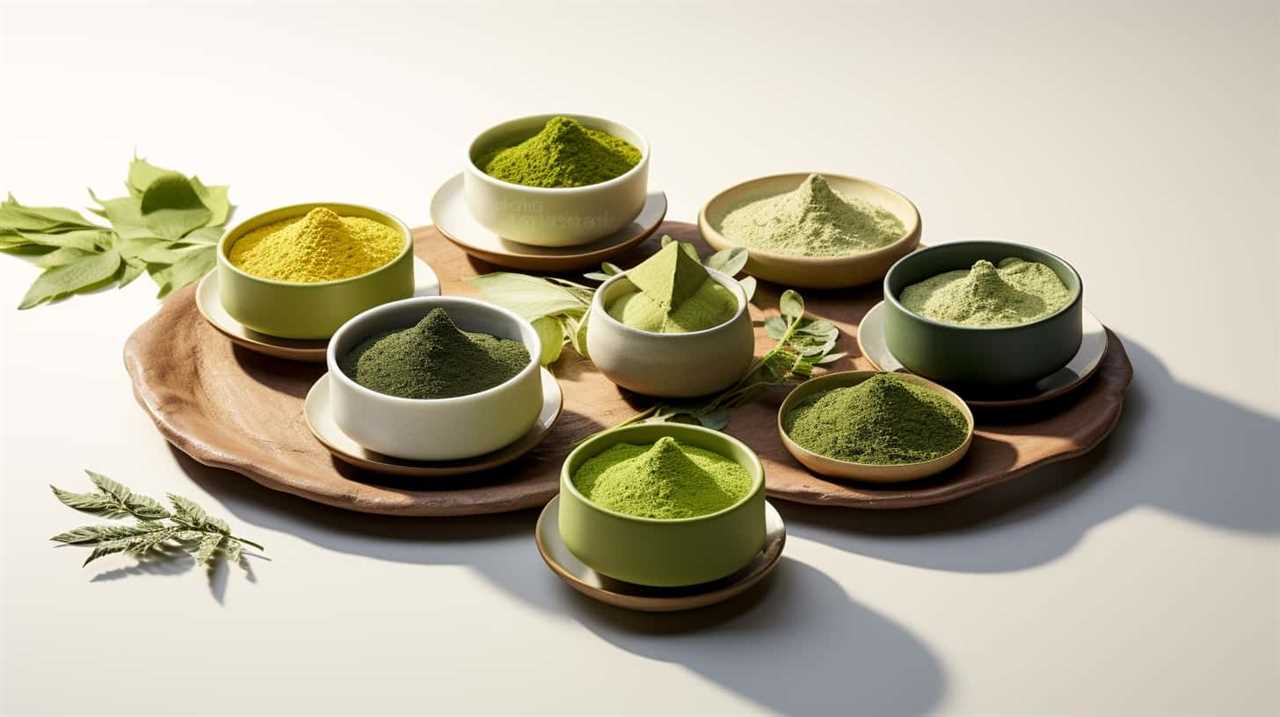
Traveling the World of Matcha
We have explored the significance of matcha in Traditional Japanese Tea Ceremonies, and now let’s embark on a journey to explore the diverse world of matcha.
Matcha hasn’t only become popular in tea ceremonies but has also made its way into various aspects of popular culture and beauty products. Here are four fascinating ways matcha has made its mark:
- Matcha in popular culture: Matcha has become a trendy ingredient in culinary creations, from matcha-flavored ice cream and pastries to matcha-infused cocktails. Its vibrant green color and unique flavor have captivated food enthusiasts around the world.
- Matcha in beauty products: Matcha’s antioxidant properties have made it a sought-after ingredient in skincare and beauty products. From facial masks to scrubs, matcha is believed to rejuvenate the skin, reduce inflammation, and provide a natural glow.
- Matcha-inspired rituals: Beyond tea ceremonies, matcha has inspired new rituals and experiences. Matcha tastings and workshops allow people to explore the different grades and flavors of matcha while learning about its rich history and cultural significance.
- Matcha in wellness: Matcha’s health benefits have led to its incorporation in wellness practices. Matcha lattes and smoothies have become popular choices for those seeking a natural energy boost and a dose of antioxidants.
As we delve deeper into the world of matcha, we discover its versatility and influence in various aspects of our lives. Whether sipping a cup of matcha tea or indulging in matcha-flavored treats, this vibrant green powder continues to captivate and inspire.
Tips for Buying and Storing Matcha
How can we ensure that we’re buying and storing matcha properly?

When it comes to buying matcha, it’s important to choose a reputable source. Look for matcha that’s vibrant green in color, as this indicates freshness. Avoid matcha that’s dull or brownish in color, as it may be stale or of lower quality. It’s also recommended to buy matcha in small quantities to ensure maximum freshness.
When it comes to storing matcha, it’s crucial to keep it in an airtight container to prevent exposure to light, air, and moisture. Matcha is highly sensitive to these elements, which can affect its flavor and quality. Store matcha in a cool, dry place away from direct sunlight, such as a pantry or cupboard. It’s best to consume matcha within a few months of opening the package to ensure optimal taste and freshness.
Frequently Asked Questions
How Long Does Matcha Stay Fresh After It Is Opened?
Matcha storage tips are essential to ensure its freshness. When Matcha is opened, it should be consumed within a few weeks for the best taste and quality. Pay attention to expiration dates for optimal enjoyment.
Can Matcha Be Used in Baking Recipes?
Yes, matcha can be used in baking recipes. It adds a unique flavor and vibrant green color to cakes, cookies, and even breads. Using matcha in savory dishes or incorporating it into drinks are also popular options.

Is Matcha Safe for Pregnant Women?
When it comes to matcha and pregnancy, it’s important to consider the potential risks. Is matcha safe for pregnant women? We’ll explore the possible dangers of consuming matcha during this delicate time.
Can Matcha Help With Weight Loss?
Matcha is a popular choice for weight loss due to its high antioxidant content. Compared to green tea, matcha provides a more concentrated dose of nutrients. Incorporating matcha into smoothie recipes can be a tasty way to support weight loss goals.
How Does Matcha Compare to Other Types of Tea in Terms of Caffeine Content?
When comparing caffeine content, matcha reigns supreme among teas. It surpasses green tea with its vibrant green hue and leaves coffee in the dust. Sip on matcha for a gentle boost without the jitters!
Conclusion
In conclusion, matcha is like a vibrant emerald elixir that not only tantalizes our taste buds but also offers a myriad of health benefits.
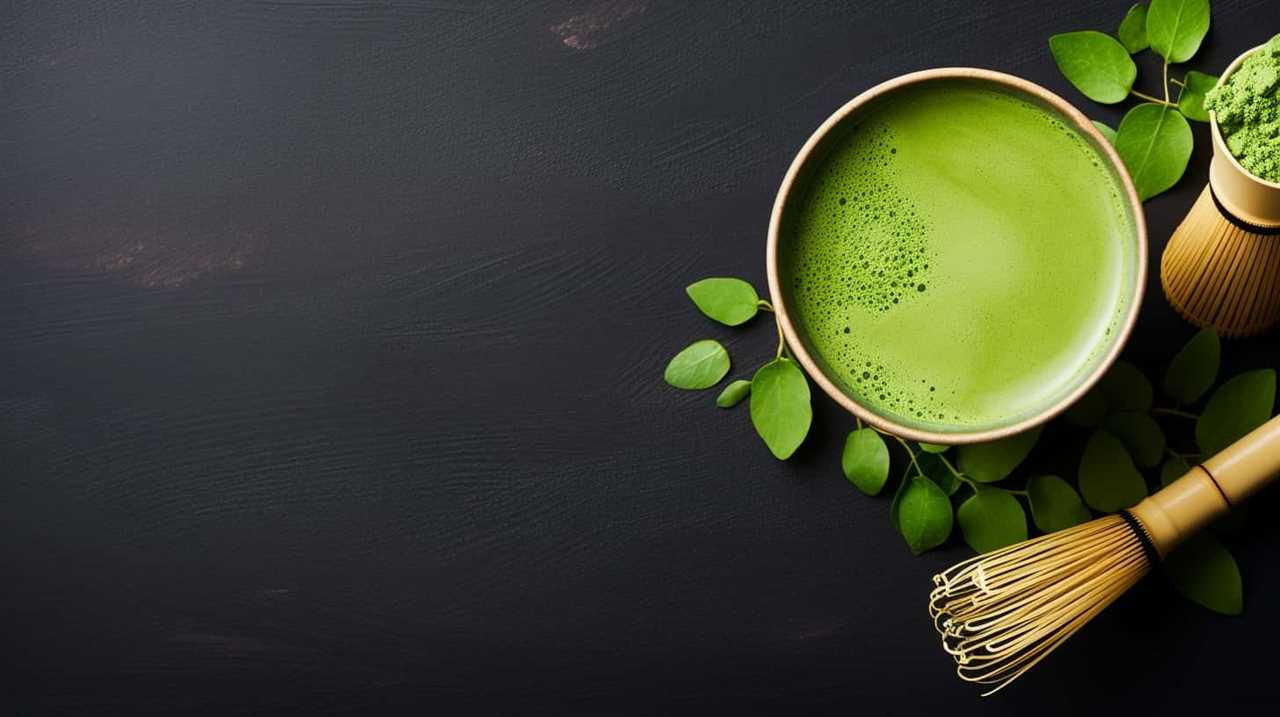
From boosting metabolism to supporting heart health, this powdered green tea has become a beloved drink worldwide.
Whether you savor it in a traditional Japanese tea ceremony or enjoy it on-the-go, exploring the world of matcha is a journey worth taking.
So, grab your matcha whisk and delve into this enchanting and invigorating drink.
Justin is a seasoned author, coffee and tea enthusiast, and an essential member of the Cappuccino Oracle team. With a keen appreciation for the complexities of coffee, coffee alternatives, and tea, Justin has dedicated his professional career to exploring these realms and sharing his insights with readers worldwide.
Justin’s immersion in the world of coffee, coffee alternatives, and tea began at a young age, kindling a passion that extended beyond mere consumption. This love for these beverages led him to combine his talent for writing with his devotion to coffee and tea, bringing him to Cappuccino Oracle as a dedicated author.
Matcha
Unveiling The Mysteries Of Matcha: Insights On Its Origins, Production, And Quality

Have you ever been curious about the mysteries behind the rich and natural flavors of matcha? If so, get ready to join me on an adventure as we uncover the secrets of matcha, delving into its origins, production, and quality.
As a lover of all things tea, I have delved deep into the world of matcha, immersing myself in its rich history and intricate production process. From the shade-grown tea leaves to the meticulous grinding technique, every step is a labor of love that culminates in the velvety smooth powder we know as matcha.
Join me as we unravel the secrets behind this ancient Japanese tradition and discover why quality is key when indulging in this verdant elixir. We’ll explore the nuances of flavor, the importance of sourcing, and even delve into the fascinating world of other tea varieties.
So grab a cup, sit back, and let’s dive into the captivating world of matcha.
Key Takeaways
- Matcha tea is made from powdered green tea leaves and has a long and labor-intensive production process.
- Premium matcha is made from the first harvest in early spring, using the top 3 sprouts of the tea plant and ground tencha leaves.
- Cheaper matchas may skip some steps in the production process and are more suitable for matcha lattes.
- High-quality matcha is recommended for sparing consumption, as it has a smoother flavor and more health benefits compared to cheaper matchas.
What is matcha?
I’ve learned that matcha is a powdered green tea made from special tea leaves that are shaded before harvest, and it has a long and labor-intensive production process.
There are different types of matcha available, but the premium matcha is made from the first harvest in early spring, using only the top 3 sprouts of the tea plant. The leaves are then steamed, dried, and have their stems removed before being ground into a fine powder using a specialized mill made of granite.
It’s important to note that high-quality matcha is recommended for sparing consumption, as it has a complex production process that results in a smooth flavor. Matcha also offers various health benefits, such as being rich in antioxidants, boosting metabolism, and improving mental alertness.
Production process
The matcha production process involves shading the tea leaves before harvest and selecting the top three sprouts of the tea plant for premium matcha. Shading is a technique used to enhance the flavor and quality of the tea leaves. By covering the tea plants with shade, the leaves produce more chlorophyll and amino acids, resulting in a vibrant green color and a rich, umami taste.
After the shading period, only the top three sprouts of the tea plant are carefully handpicked for premium matcha. These selected leaves, known as tencha leaves, are then steamed, dried, and have their stems removed.
Finally, the tencha leaves are ground into a fine powder using a specialized granite mill. This process results in the smooth and concentrated matcha powder that we enjoy.
Quality and consumption
Let me tell you, indulging in high-quality matcha is like sipping a vibrant green elixir that awakens your taste buds and nourishes your body with its rich flavor and numerous health benefits. Matcha’s health benefits are truly remarkable. Packed with antioxidants, vitamins, and minerals, matcha is known to boost metabolism, enhance focus and concentration, and strengthen the immune system.
But not all matcha is created equal. Different grades of matcha exist, ranging from ceremonial grade to culinary grade. Ceremonial grade matcha is made from the highest quality tencha leaves and has a smooth, vibrant green color and a delicate, umami flavor. It is best enjoyed on its own, whisked with hot water.
On the other hand, culinary grade matcha is more affordable and is suitable for making matcha lattes, smoothies, and baked goods. Although it may have a slightly bitter taste and a duller color, it still provides health benefits.
So, whether you choose to indulge in high-quality ceremonial grade matcha or opt for the more affordable culinary grade, incorporating matcha into your routine is a delicious way to reap its health benefits.
Frequently Asked Questions
What are some popular ways to enjoy matcha besides drinking it as tea?
Besides drinking matcha as tea, some popular ways to enjoy it include indulging in matcha desserts like matcha ice cream, matcha cake, and matcha cookies. Additionally, matcha smoothies are a refreshing and healthy option.
Are there any specific health benefits associated with consuming matcha?
I’m no expert, but matcha is said to have potential health benefits. Some claim it can aid in weight loss due to its high antioxidant content and metabolism-boosting properties. However, more research is needed to confirm these claims.
How does the quality of matcha affect its flavor and overall experience?
The quality of matcha directly affects its flavor and overall experience. Higher quality matcha, made from carefully selected leaves and processed with precision, offers a smoother and more vibrant flavor, while lower quality matcha may have a less appealing taste and color.
Can matcha be used in cooking or baking?
"Where there’s matcha, there’s a way! Matcha can be used in a variety of cooking and baking recipes, adding a vibrant green color and a unique earthy flavor to dishes like matcha desserts."
Are there any specific tips or techniques for properly preparing matcha tea at home?
To properly prepare matcha tea at home, start by sifting the matcha powder to remove any clumps. Then, choose water at around 175°F to 180°F for the best flavor. Gradually add water to the matcha and whisk in a "W" or "M" motion until frothy. Enjoy!
Conclusion
In conclusion, matcha tea is not just a beverage, but a rich and fascinating tradition that has evolved over centuries.
From its origins in Japan to its intricate production process, matcha is a labor of love.
The quality of matcha is crucial, as the steps taken in its production directly impact its flavor and aroma.
Whether you’re a matcha connoisseur or a beginner, there is a matcha tea out there for you.
So, why not indulge in a cup of this vibrant green elixir and experience the magic of matcha for yourself? It’s a journey worth embarking on!
Arf, an author and an innovative enthusiast of coffee, coffee alternatives, and tea, plays a crucial role as a contributor to the esteemed Cappuccino Oracle platform. Renowned for his curiosity and passion for these captivating beverages, Arf has carved out a unique space for himself in the world of exploration and writing. He realized that coffee, coffee alternatives, and tea are not mere drinks to keep one awake, but universes of flavors and stories waiting to be explored.
Arf’s articles for Cappuccino Oracle blend meticulous research with personal experiences, providing readers with an in-depth understanding of various types of coffee, coffee alternatives, and tea, along with their unique characteristics, cultures, and histories. His honest reviews and engaging narratives guide readers on their own journeys, helping them discover their preferences and find their perfect brew.
Matcha
Unveiling The Truth Behind Starbucks’ Matcha: A Disappointing Blend

Being a lover of tea, I was eager to sample Starbucks’ matcha beverages, anticipating a flavorful and genuine taste. However, to my dismay, I found that it was a subpar mixture of inexpensive green tea powder and an excessive amount of sugar. This was a stark contrast to the customary matcha experience that I had grown accustomed to.
The use of low-quality matcha by Starbucks is driven by the need for mass production and a consistent taste across all locations. But in this pursuit, they have sacrificed the true essence of matcha. Authentic matcha production involves meticulous steps to ensure a high-quality and flavorful product, steps that Starbucks seems to skip.
The result is a matcha latte packed with 32 grams of sugar, equivalent to a can of soda, and a whopping 240 calories. It’s time to unveil the truth behind Starbucks’ matcha and explore better options for a truly satisfying tea experience.
Key Takeaways
- Starbucks uses a cheap green tea powder for their matcha drinks, which may not even be considered matcha.
- The cheap matcha powder is mixed with a lot of sugar, negating the health benefits and undermining the quality of the tea.
- Starbucks’ matcha latte contains a high amount of sugar, similar to a can of soda, and has a significant number of calories.
- To have a better matcha experience, it is recommended to explore premium, first harvest matcha made by talented farmers in Japan and to try different matcha options to find preferred taste.
What is Starbucks Matcha?
Starbucks Matcha is a cheap green tea powder mixed with a high amount of sugar, which not only undermines the health benefits of matcha but also fails to deliver the natural, great-tasting flavor of authentic matcha tea.
The ingredients used in Starbucks matcha include low-quality green tea powder that is likely produced on a large scale. Unlike traditional matcha production methods, Starbucks skips certain steps to save time and money. These steps, such as shading the tea plants to reduce bitterness and selecting the top leaves for their flavor and nutrients, are crucial in creating high-quality matcha.
Instead, Starbucks opts for a blend of cheap green tea powder mixed with sugar, resulting in a dull and bitter flavor. This disappointing blend of ingredients does not live up to the standards of true matcha tea.
Quality vs. Cheap Matcha
Indulging in high-quality matcha is like savoring a delicate melody that dances on your taste buds, while settling for cheap matcha is akin to a discordant symphony that leaves a bitter aftertaste. When it comes to matcha, quality matters. Traditional matcha production is an art that requires time, patience, and attention to detail. The importance of shading the tea plants, selecting the top leaves, and using a stone mill to grind the leaves into a fine powder cannot be overstated. These steps not only enhance the flavor but also preserve the health benefits of matcha. High-quality matcha is rich in antioxidants, boosts metabolism, and promotes a sense of calm. On the other hand, cheap matcha often lacks these qualities as it skips crucial steps and is mixed with sugar and other additives. Don’t settle for a subpar matcha experience; choose high-quality matcha for its exceptional taste and health benefits.
| Traditional Matcha Production |
|---|
| Shading the tea plants |
| Selecting the top leaves |
| Grinding with a stone mill |
The importance of traditional matcha production cannot be overstated. These steps not only enhance the flavor but also preserve the health benefits of matcha. High-quality matcha is rich in antioxidants, boosts metabolism, and promotes a sense of calm. On the other hand, cheap matcha often lacks these qualities as it skips crucial steps and is mixed with sugar and other additives. Don’t settle for a subpar matcha experience; choose high-quality matcha for its exceptional taste and health benefits.
Recommendations for Better Matcha
Exploring different matcha options can lead to a better matcha experience. When it comes to matcha, not all options are created equal. While Starbucks may offer a convenient matcha latte, there are alternative options that provide a more authentic and higher quality experience.
Premium matcha, specifically first harvest matcha, is made by talented farmers in Japan and can be enjoyed plain, without the need for excessive sugar or additives. By choosing premium matcha, you can reap the full benefits that matcha has to offer, such as its high antioxidant content and potential health benefits.
Additionally, exploring different types of matcha, such as Japanese black tea, can expand your taste palate and introduce you to new and exciting flavors. So, why settle for a disappointing blend when there are better matcha options out there waiting to be explored?
Frequently Asked Questions
How is Starbucks matcha different from traditional matcha?
Starbucks matcha differs from traditional matcha in terms of quality and taste. One interesting statistic is that Starbucks’ matcha latte contains 32 grams of sugar, similar to a can of soda, which undermines the health benefits of matcha.
What are the health benefits of matcha and how do they differ between Starbucks matcha and premium matcha?
The health benefits of matcha include high levels of antioxidants, increased energy, and improved focus. However, Starbucks matcha quality is compromised due to the use of cheap powder mixed with sugar, negating these benefits.
Can you customize the sweetness level of Starbucks matcha drinks?
Yes, you can customize the sweetness level of Starbucks matcha drinks. They offer popular matcha drink variations like matcha latte and matcha frappuccino, allowing customers to choose the amount of sweetener they prefer.
Are there any alternative options for matcha drinks at Starbucks?
Yes, there are alternative options for matcha drinks at Starbucks. However, it’s important to note that the taste may not be comparable to traditional matcha. Exploring different matcha options and Japanese black tea can provide a better experience.
What are the steps involved in producing high-quality matcha and how does Starbucks’ matcha production differ?
Starbucks’ matcha production process differs from traditional matcha production in Japan. High-quality matcha involves shading the tea plants, selecting the top leaves, steaming, drying, and grinding them. However, Starbucks skips these steps, resulting in a lower quality and less authentic matcha experience.
Conclusion
In conclusion, after delving into the truth behind Starbucks’ matcha, it’s clear that their blend falls short of expectations. The use of cheap green tea powder mixed with excessive sugar dilutes any potential health benefits and fails to deliver an authentic matcha experience.
To truly enjoy the rich and flavorful taste of matcha, it’s recommended to explore premium, first harvest options crafted by skilled Japanese farmers. Don’t settle for subpar matcha; treat yourself to a tea experience that’ll leave your taste buds dancing with delight.
Arf, an author and an innovative enthusiast of coffee, coffee alternatives, and tea, plays a crucial role as a contributor to the esteemed Cappuccino Oracle platform. Renowned for his curiosity and passion for these captivating beverages, Arf has carved out a unique space for himself in the world of exploration and writing. He realized that coffee, coffee alternatives, and tea are not mere drinks to keep one awake, but universes of flavors and stories waiting to be explored.
Arf’s articles for Cappuccino Oracle blend meticulous research with personal experiences, providing readers with an in-depth understanding of various types of coffee, coffee alternatives, and tea, along with their unique characteristics, cultures, and histories. His honest reviews and engaging narratives guide readers on their own journeys, helping them discover their preferences and find their perfect brew.
Matcha
The Ultimate Guide To Using Chashaku: Your Matcha Essential

Being a lover of matcha, I am aware that the crucial factor in achieving the perfect matcha bowl is the equipment we utilize. When it comes to preparing matcha, there is one tool that is particularly essential: the chashaku.
This bamboo spoon, with its elegant design and precise measurements, is the secret weapon of matcha lovers worldwide. In this ultimate guide, I will take you on a journey through the history and evolution of the chashaku, and show you how to use it like a pro.
From its origins as a metal or ivory scoop to its modern-day incarnation in bamboo, the chashaku has come a long way. With its 48° bend and 18mm length, it effortlessly scoops the perfect amount of matcha from its container.
So grab your chashaku and get ready to elevate your matcha game to new heights. Let’s dive in and discover the wonders of this matcha essential.
Key Takeaways
- Chashaku is a bamboo spoon used to scoop matcha powder in the Japanese tea ceremony and by matcha lovers worldwide.
- Chashaku is one of the three important tea utensils used in the tea ceremony and is about 18mm in length with a 48° bend at the end for scooping.
- Chashaku is made of bamboo to avoid negative reactions with matcha powder and is a great measurement tool for matcha powder.
- Two scoops of chashaku is the standard amount for a bowl of matcha tea, and it is easy to maneuver in matcha tins or natsume due to its small size.
What is Chashaku?
Chashaku is a bamboo spoon used to scoop matcha powder, and it’s one of the three important tea utensils used in the Japanese tea ceremony.
Made from a single piece of bamboo, this elegant tool has a long history dating back to the Muromachi period in Japan. Originally crafted from metal or ivory, chashaku evolved to be made of bamboo due to its natural properties and to avoid any negative reactions with matcha powder.
The design of chashaku is both functional and beautiful, with a length of about 18mm and a 48° bend at the end for easy scooping. There are different styles of chashaku scoops, each with its own unique shape and characteristics. The back of the chashaku has a rough texture, while the face is smooth and sleek.
Whether you’re a matcha lover or a tea ceremony enthusiast, using a chashaku adds a touch of authenticity and tradition to your matcha preparation.
History and Evolution
During the Muromachi period in Japan, the chashaku spoon evolved from being made of metal or ivory to its current bamboo form, which is about 18mm in length and has a 48° bend at the end for easier scooping. The history and evolution of the chashaku is a testament to its significance in Japanese tea ceremonies and its cultural importance in matcha preparation.
| The significance of chashaku in Japanese tea ceremonies | The cultural importance of chashaku in matcha preparation |
|---|---|
| Chashaku is one of the three important tea utensils used in the tea ceremony. | Chashaku is a great measurement tool for matcha powder. |
| Chashaku originated in Japan during the Muromachi period. | Chashaku’s small size allows for easy maneuvering in matcha tins or natsume. |
| Originally made of metal or ivory, chashaku evolved to be made of bamboo. | Chashaku is made from a single piece of bamboo and shaped with a bend for the scoop. |
| Chashaku is made of bamboo to avoid negative reactions with matcha powder. | The back of chashaku has a rough texture, while the face is smooth and sleek. |
The chashaku’s role in Japanese tea ceremonies cannot be understated. It is one of the three essential utensils used in the tea ceremony, alongside the chawan (tea bowl) and chasen (tea whisk). The chashaku’s small size and precise measurement make it the perfect tool for scooping matcha powder. Its evolution from metal or ivory to bamboo shows the cultural importance placed on this utensil. The chashaku’s design, with its gentle bend and smooth face, allows for easy and graceful scooping of matcha. Using the chashaku is not only practical but also a way to honor the centuries-old tradition of matcha preparation.
How to Use Chashaku
To use the chashaku, I simply hold it like a pencil and dip the scoop into the matcha container. Then, I carefully lift the chashaku scoop out and place it over the matcha bowl to dump the powder.
It’s a simple and elegant technique that ensures the perfect amount of matcha every time.
But did you know that there are alternative ways to use the chashaku? Some matcha lovers prefer to use a teaspoon or a regular spoon to scoop their matcha powder. While these alternatives may work in a pinch, they don’t offer the same precision and authenticity as the chashaku.
The chashaku’s unique design and size make it the ideal tool for measuring matcha powder. Plus, using the chashaku adds a traditional touch to the matcha preparation process, enhancing the overall experience.
So why settle for anything less? Embrace the chashaku and elevate your matcha game to the next level.
Frequently Asked Questions
What are the different types of materials used to make chashaku besides bamboo?
There’s something truly magical about the chashaku, the bamboo spoon that gracefully scoops matcha powder. While bamboo is the traditional material, chashaku can also be made from metal or ivory, although these alternatives are less common.
Can chashaku be used to scoop other powders besides matcha?
Yes, chashaku can be used to scoop other powders besides matcha. However, it is primarily designed for scooping matcha powder and is most commonly used in Japanese tea ceremonies. To properly clean and care for a chashaku, it is recommended to wipe it with a dry towel or tissue to avoid water damage. The chashaku is a versatile tool with different uses in the tea ceremony, making it an essential item for matcha lovers.
How long does a chashaku typically last before it needs to be replaced?
A chashaku typically lasts for a long time, but the lifespan can vary depending on the material. Bamboo chashaku is the most common and durable option, while metal or ivory may wear down over time. Proper care involves cleaning with a dry towel or tissue to avoid water damage.
Can chashaku be used with different types of matcha bowls or is it specific to a certain style?
Absolutely! Chashaku can be used with various types of matcha bowls, adapting to different styles. Its small size and unique design make it perfect for scooping matcha powder and adding a touch of elegance to your matcha preparation.
Are there any alternative utensils that can be used in place of chashaku for scooping matcha powder?
Yes, there are alternative utensils for scooping matcha powder, such as a teaspoon or a small spoon. However, using a chashaku has its benefits. Its unique design allows for precise measurements and easy maneuvering in matcha tins.
Conclusion
In conclusion, using chashaku isn’t just a practical way to measure and scoop matcha powder, but it’s also an essential tool for embracing the art and tradition of the Japanese tea ceremony.
While some may argue that using a regular spoon can achieve the same result, chashaku offers a unique experience that connects us to centuries of tea culture. Imagine holding the slender bamboo spoon, feeling the weight of tradition in your hand, and delicately scooping the vibrant green matcha powder.
It’s a sensory journey that brings us closer to the beauty and mindfulness of matcha preparation. So, embrace the chashaku, and let it elevate your matcha experience to new heights.
Arf, an author and an innovative enthusiast of coffee, coffee alternatives, and tea, plays a crucial role as a contributor to the esteemed Cappuccino Oracle platform. Renowned for his curiosity and passion for these captivating beverages, Arf has carved out a unique space for himself in the world of exploration and writing. He realized that coffee, coffee alternatives, and tea are not mere drinks to keep one awake, but universes of flavors and stories waiting to be explored.
Arf’s articles for Cappuccino Oracle blend meticulous research with personal experiences, providing readers with an in-depth understanding of various types of coffee, coffee alternatives, and tea, along with their unique characteristics, cultures, and histories. His honest reviews and engaging narratives guide readers on their own journeys, helping them discover their preferences and find their perfect brew.
-

 Americano3 weeks ago
Americano3 weeks agoHow to Make Americano With Moka Pot
-

 Americano4 weeks ago
Americano4 weeks agoHow to Make an Americano in a French Press
-

 Americano6 days ago
Americano6 days agoHow to Make Korean Iced Americano
-

 Americano3 weeks ago
Americano3 weeks agoHow to Make Iced Americano With Instant Coffee
-

 Americano3 weeks ago
Americano3 weeks agoWhat to Add to an Americano at Starbucks
-

 Americano4 weeks ago
Americano4 weeks agoHow to Make Americano With a Nespresso Machine
-

 Americano3 weeks ago
Americano3 weeks agoHow to Make Americano With Bialetti
-

 Americano3 weeks ago
Americano3 weeks agoHow to Make Dutch Bros Americano









